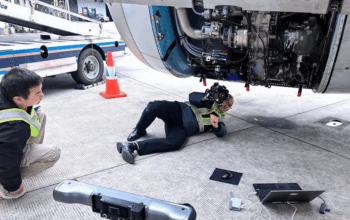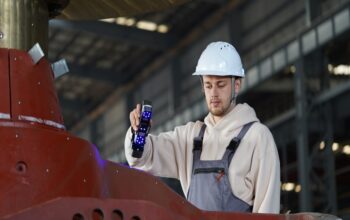Ever wondered how professionals capture precise 3D models of cars? 3D scanning technology has revolutionized the way we document and analyze vehicles, from classic restorations to modern enhancements.
Whether you’re an automotive enthusiast or a professional in the industry, understanding how to 3D scan a car can open up a world of possibilities.
This article will guide you through the step-by-step process of 3D scanning a car, ensuring you get the most accurate and detailed results.

Applications of 3D Scanning in the Automotive Industry
3D scanning technology offers numerous applications in the automotive industry, providing significant benefits for various processes and projects.
Restoration and Preservation: 3D scanning allows for precise documentation of classic and vintage cars, preserving details and aiding in accurate restorations.
This technology captures every detail for exact replication, maintaining the originality and integrity of historic vehicles.
Additionally, 3D visualisation of cars creates lifelike digital models, enabling restorers to view and manipulate the car’s design in a virtual environment, facilitating precise restoration planning.
 Customization and Modification: Car enthusiasts and professionals can use 3D scans to design custom parts and modifications, ensuring perfect fits and seamless integrations.
Customization and Modification: Car enthusiasts and professionals can use 3D scans to design custom parts and modifications, ensuring perfect fits and seamless integrations.
This allows for highly personalized modifications without the need for extensive trial and error. 3D scanners can help provide exact measurements, reducing the risk of errors and ensuring that custom parts fit perfectly on the first try.

Quality Control and Inspection: Manufacturers can use 3D scanning for quality control and inspection, detecting any deviations or defects in car parts and ensuring they meet precise specifications.
Full-field data capture helps in generating detailed inspection reports, ensuring high-quality production standards. This is particularly useful in maintaining consistent quality across large batches of parts, reducing waste and rework.

Reverse Engineering: 3D scanning enables reverse engineering of car components, allowing for the creation of detailed CAD models for manufacturing or analysis.
This is particularly useful for creating accurate replicas of existing parts that may no longer be in production.
Engineers can use these models to understand the design and improve upon it, or to create new parts that fit seamlessly with existing components.

Best 3D Scanner for Automotive Use
Choosing the right 3D scanner for automotive applications is key to obtaining precise and reliable scans. There are several factors to consider when selecting a 3D scanner for car parts and car bodies.
Accuracy is one of the most critical features. Look for scanners that offer high resolution and precision to capture the intricate details of car components.
Ease of use is another important factor. Scanners with user-friendly interfaces and straightforward setup processes can significantly streamline your workflow.
Compatibility with software is also essential. Ensure that the scanner you choose works well with the 3D modeling software you plan to use.
Here are some recommended scanners for automotive use:
SCANTECH KSCAN-Magic Series Handheld 3D Scanner: Known for its high accuracy and versatility, this handheld scanner features dual laser scan modes, built-in photogrammetry, and the ability to scan large objects with high precision. It’s ideal for detailed scans of car parts and entire vehicles.

TrackScan-Sharp Series 3D Measurement System: This system offers precise tracking and measurement capabilities without requiring markers.
It’s perfect for capturing complex geometries and large surfaces, providing high accuracy and reliable results, particularly useful for scanning entire car bodies and large components.

NimbleTrack Wireless 3D Scanning System: A cutting-edge wireless system that provides flexibility and ease of use, making it suitable for various automotive scanning applications.
With its compact size, dual power cycle, and target-free scanning, it allows for high-precision scanning anywhere, anytime, without being constrained by environmental limitations.

How to 3D Scan a Car
So, if we have a 3D scanner, how do we scan a car? To get started with 3D scanning a car, it’s essential to follow some basic steps. These initial steps will ensure that your scanning process is smooth and effective.
1. Setting Up:
Turn on the 3D scanner and connect it to your computer or tablet. SCANTECH NimbleTrack supports quick set-up with its compact size and no cable.
Open the scanning software and configure the settings according to the manufacturer’s instructions.
If necessary, place markers or targets on the car to improve scan accuracy. Scantech Tracking 3D System and iReal Series Color 3D Scanners offer a markerless alignment approach, which can be more convenient and faster for some users.

2. Calibration
Follow the scanning software’s instructions to calibrate your scanner, ensuring optimal accuracy and performance.
Calibration is crucial as it adjusts the scanner to account for any environmental variations, ensuring that your scans are precise and reliable.
3. Scanning
Start at one end of the car and move around it, capturing the surface from multiple angles. Move the scanner smoothly and consistently, maintaining a steady hand and a consistent distance from the car’s surface.
Ensure that each scan overlaps with the previous one to cover the entire surface and avoid missing any details.

4. Generate the 3D Model
Make any necessary adjustments in the software to enhance the scan quality. Use the software’s features to merge the scans and generate a complete 3D model of the car.
Tools such as noise reduction, hole filling, and mesh optimization can be very helpful in refining the final model.
 Cost to 3D Scan a Car
Cost to 3D Scan a Car
Sometimes, if we can’t afford a 3D scanner or only need to scan a car for a one-time project, we can consider using a 3D scanning service.
The cost of 3D scanning a car can vary depending on several factors, primarily the complexity of the car’s design and the level of detail required in the final model. More intricate and detailed 3D models demand more time and expertise, thereby increasing the overall cost.
Human labour is a significant factor; 3D engineers spend considerable time ensuring that each scan is precise and meets the desired quality standards.
The size of the car also influences the cost. Larger vehicles require more scanning time and potentially more complex data processing.
Additionally, the purpose of the scan can affect the price. For instance, scans intended for high-resolution, detailed replicas or restorations will generally cost more than those needed for simpler applications.
Customers should consider their specific needs, such as the intended use of the 3D model and the required level of detail. By clearly communicating these needs to 3D scanning team, they can provide a more accurate cost estimate.
Moreover, Scantech pricing structure aims to be transparent, ensuring that customers understand the breakdown of costs associated with the 3D scanning service.
Overall, while the initial cost may seem high, the investment in high-quality, precise 3D scanning can save time and resources in the long run by reducing errors and ensuring accurate reproductions or restorations.
Conclusion
In summary, 3D scanning technology has transformed the automotive industry by enabling precise documentation, customization, and quality control.
Whether for restoring classic cars, designing custom modifications, or ensuring manufacturing standards, 3D scanning offers unparalleled accuracy and efficiency.
By following a structured process of setting up, calibrating, scanning, and generating the 3D model, automotive professionals can achieve high-quality results.
Investing in high-quality scanning services, like those provided by Scantech, can save time and resources in the long run, offering significant benefits across various automotive applications.
We encourage you to try 3D scanning your car and explore the potential applications it can bring to your projects. With the right tools and approach, you’ll be able to capture stunningly precise 3D models and unlock new possibilities in the automotive world.









